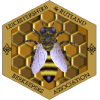Gardeners’ Friends -The World of Wild Bees
This article is not about honeybees, which are domesticated, live in beehives and are looked-after by bee-keepers. It is about the 250 other types of bee which live wild in Britain. Many of them share our gardens with us, and about a quarter of them are considered rare or endangered. Gardens are very important for their conservation.
Bumble Bees – the basics
There is not room here to go into detail. So here are just a few basic facts. There are five or six species of bumble bees which London gardeners can expect to see regularly, if you have a healthy local environment with plenty of suitable flowers for forage, and undisturbed tussocky or stony areas of ground where they can be left to hibernate in winter and build their nests in spring and summer.
Bumblebee queens establish nests in spring, sometimes under the ground (often in disused mouse burrows) or above the ground in dry tussocks of dead grass or moss. Because of their furry coats they can fly in cooler weather than other bees and are often seen early in the year, when they are heavily dependent on early garden plants for nectar and pollen. They collect both of these substances for food. Bumblebees are important as pollinators of early-flowering fruit bushes and trees such as blackcurrants, gooseberries, cherries and Plums.
Bumblebee species can be identified according to the combinations of red, yellow and white bands on their coat. See the recommended books (below) for more information about identification. I have identified the following illustrations to the best of my ability, but these identifications may not be accurate, and I’m happy to be corrected.
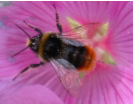


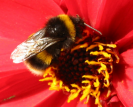
Although they have stings, bumblebees are more docile than honeybees and do not sting unless seriously provoked. Like all bees, bumblebees are extremely susceptible to insecticide sprays (including organic insecticides) and these should not be used. We have tried out several bumblebee nest boxes in our garden, however bumblebees are known to be reluctant to take to artificial nestboxes and that has been our experience. Nest boxes are very expensive, and gardening merchandise catalogues have jumped on a ‘wildlife gardening’ bandwagon, to lighten the wallets of gardeners concerned about conservation. An alternative approach, which costs nothing, is to leave areas of dry tussocky grass, moss, piles of dry sticks and dry logs, banks of dry turf, and heaps of stones or sand somewhere in your garden, where bumblebees and other kinds of wild bees can find their own nest sites. If you want to try making your own bumblebee nest boxes, and more to the point, persuade bees to use them, you should read the book by Intenthron & Gerrard (details follow).
Recommended Books about bumblebees
- Field guide to the Bumblebees of Great Britain and Ireland, by Mike Edwards and Martin Jenner, Ocelli, 2009 (Second Edition). ISBN 978-09549713-1-1
A small paperback with clear identification details and photographs, useful plant lists, and a section about ‘gardening for bumblebees’. The best introductory work.
- Making Nest for Bumblebees, by Manfred Intenthron and John Gerrard, published by IBRA 1999. No ISBN.
- Bumblebees, by Ted Benton.Collins New Naturalist series, 2006. ISBN 0-00-717451-9
A comprehensive, detailed work with the latest information about their taxonomy and conservation status.
Flowers for Bumblebees
Bumblebees are ‘generalists’ which means that they can forage on a wide range of flowers. So they find lots of garden flowers to their liking. Different bumblebees species have different tongue lengths which means they can exploit different flowers, those with longer tongues being able to take nectar from deeper tubular flowers.
The flowers which are most popular with bumblebees tend to the members of five plant families: Daisy family (Asteraceae), Mint family (Lamiaceae), Figwort family (Scrophulariaceae), Peas, vetches and clovers (Fabaceae) and the Borage family (Boraginaceae).
Especially good for bumblebees are Knapweeds (Centaurea), thistle-like plants (Cirsium, Cynara, Echinops, Silybum,), Native Goldenrod (Solidago virgaurea), Blue- or purple-flowered sages (Salvia officinalis, S. pratensis, S. horminoides, S. verticillata etc.- not scarlet flowered ones), White Deadnettle (Lamium album) and other species of Lamium, Catmints (Nepeta and Calamintha), Woundworts and Betony (Stachys species), Lungwort (Pulmonarias – go for the blue-flowered ones), Comfrey (Symphytum), Borage, large-flowered Foxgloves such as Digitalis purpurea and D. grandiflora, Sea Hollies (Eryngium: all species, including the South American ones such as E. agavifolium), Veronica spicata, Buddleja globosa and Buddleja X weyeriana, and Clovers (Trifolium), especially Red Clovers (T. pratense and T. medium). They also visit the flowers of soft fruit such as currants and raspberries, broad beans.
Many aromatic herbs are also suitable, including all forms of Thyme, Rosemary, Hyssop, Agastache, and wild-type Lavenders such as Lavandula spica. The highly hybridised lavenders which are currently offered in DIY superstores and garden centres (L. Stoechas) are not good for bees. Tall forms of Rosemary can be allowed to grow into a loose hedge and are an excellent nectar source in early spring. Winter flowering honeysuckle (Lonicera X purpusii) is also an excellent early spring nectar and pollen source which should be in all gardens. It attracts lots of insects on warm sunny days.
Scarlet and orange – coloured flowers from North or South America or the Southern hemisphere are often not suitable for bees, having evolved for bird pollination.
Solitary bees – harmless and fascinating
All the other 240 or so wild bee species are called ‘solitary bees’ because none of them builds communal nests. None of them is going to sting you and most do not even have stings. They typically lay their eggs in small cells which they construct in tunnels under the ground, or in soft sandy banks, old mortar, dry stone walls, or in tubes or tunnels in dead wood. Each species has very specific needs. Most of them have a short season, perhaps a month or so, when they can be seen flying in the garden as adults. The rest of the year the Wild Bees 3 of 5 species survive in the form of larvae, that grow in their cells eating the store of pollen that their mother left for them when she laid the egg and walled up the cell.
Again a number of the solitary bees are extremely effective pollinators of fruit bushes and trees. In recent years gardeners have better appreciated this and it is possible to buy sets of nesting tubes that can be fixed to a fence or wall. These are very popular with Mason bees (Osmia). Home made ‘bee-houses’ can be constructed by drilling small tunnels in bricks and blocks of old, dry, untreated wood, or tying bundles of sections of chopped bamboo canes or dead Miscanthus stems together. Leave them in a dry sunny place, not on the ground but at least a metre above ground level. These will be occupied by Mason Bees and Leafcutter Bees. We have found that birds such as woodpeckers tend to use these as a winter larder, pecking them open to find the bee larvae, so it is a good idea to put the occupied bundles of canes or logs in a dry cool shed during the winter, bringing them out in March. No point in buying expensive bee houses from catalogues when you can make your own for free.
Some solitary bees we see regularly in our garden:
Lorem ipsum dolor sit amet, consectetur adipiscing elit. Ut elit tellus, luctus nec ullamcorper mattis, pulvinar dapibus leo.
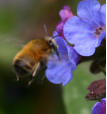
The Spring Flower Bee (Anthophora plumipes)
This emerges very early in the season (typically on the wing from mid-March). The males have yellowish faces and the females are larger and black. They dart around and can hover in front of flowers (unlike the rather slow flight of bumble bees, which tend to land on flowers). The males are territorial and will chase each other (and other flying insects!) off their patch. The males are sexually aggressive and will chase and pounce on females of the species. This bee absolutely adores early flowering Comfrey (Symphytum Hidcote Blue, and S. grandiflorum) as a nectar source. Plant either of these and you will see this bee in quantity. It also likes Viola odorata, Pulmonaria, especially P. longifolia, Cerinthe, and Green alkanet (Pentaglottis). This bee nests in tunnels in dry ground, or in old walls. It is on the wing until late May.

Mason Bees (Osmia species)
These are on the wing from April until late June or July. There are a number of species. They nest in small holes or tunnels in old mortar, crumbling walls, dry dead wood, sandy embankments, etc. The female makes a number of egg cells in each tunnel, walling each one up with mud. Osmias are very good pollinators of fruit trees and bushes, and well worth encouraging in a garden. You can buy commercial bee tubes to house them, or use bundles of cut canes, or blocks of wood or bricks into which you have drilled small tunnels.

Leafcutter Bees (Megachile species)
On the wing later in the season, these also nest in tunnels or tubes, but wall up their cells with small pieces of leaf which they cut from wild rose bushes, leaving perfect circular cuts in the rose leaves. They can be seen flying across the garden carrying pieces of leaf. They collect pollen on hairs on the lower side of their abdomen. Seem to visit a range of flowers, but they especially like Knapweeds (Centaurea), and Globe Thistle (Echinops).

Lawn Bee (Andrena fulva)
This bee makes its nest in a tunnel in short dry grass, and likes garden lawns. When the adult emerges, a small volcano-like hole is left. The female has a distinctive reddish coat and is easy to identify. If you see these on your lawn, remember that they do not sting and are completely harmless. Several other common species of Andrena live in the ground. In the winter urban foxes dig small holes in our lawn as they search for the Lawn Bee larvae in their underground cells.
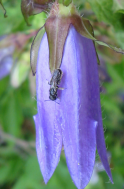
Harebell Bee (Chelostoma campanularum)
This is Britain’s smallest bee, and is dependent on Bellflowers (Campanulas). It is very small, and black in colour. When I first noticed lots of these tiny bees visiting our Campanula trachelium I had no idea what they were and thought they must be some kind of fly. It nests in tiny tunnels (‘woodworm’ holes) in dead wood. A good example of a ‘specialist’, which is dependent on a few species of Campanula, which have to be growing near its nest habitat.

Wool-carder Bee (Anthidium manicatum)
Very common in gardens, found later in the summer visiting its favourite flower, ‘Lamb’s Ear’ (Stachys byzantina). It cuts the silky hairs from the Lamb’s Ear leaf and uses them to line its nest-cells, rather like the fleece lining of a sleeping bag. It is territorial and will defend a good plant against rivals. It will also gather hairs from Rose Campion (Lychnis coronaria). It visits a wide range of flowers, but seems to especially like Asteraceae (daisy family), all kinds of Stachys, small- flowered foxgloves such as Digitalis ferruginea and D. lutea, and Linaria purpurea.
Books about solitary bees
Strangely, there is no single book for the general reader about solitary bees. You have to look in general insect guides. Various books by Michael Chinery, such as Complete British Insects (Collins 2005) are a good place to start.
- All but one of the illustrations on this information sheet were taken in our London garden.
- You are welcome to print this text for personal use or to use for educational purposes
- © Marc Carlton 2010
- Email: fwg@phonecoop.coop
- Website: www.foxleas.com
